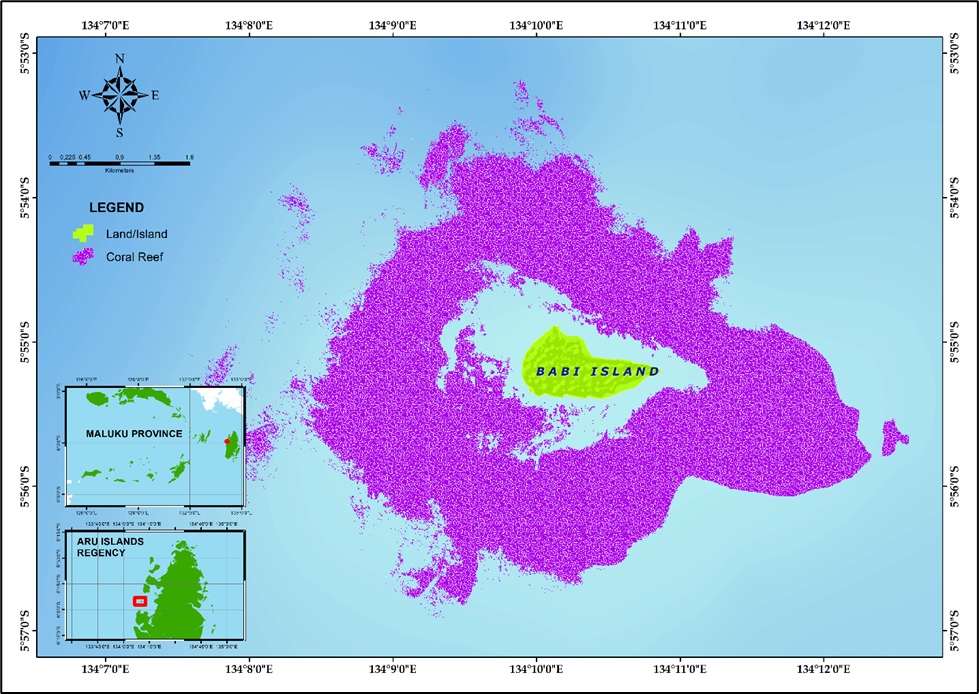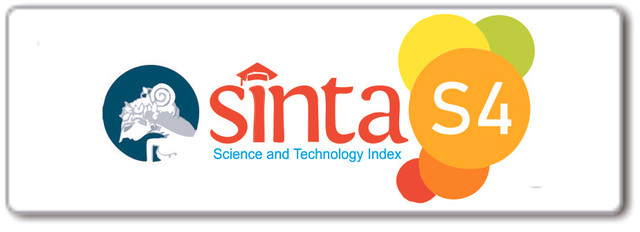Spatial Distribution of Coral Reefs in the Waters of Babi Island, Aru Islands Regency
Abstract
This study analyzes the spatial distribution of coral reefs surrounding Babi Island, Aru Islands Regency, Indonesia. The research aims to understand the condition of the coral reefs, create coral reef maps, and monitor their health. Satellite imagery and transect surveys were used to determine coral reef area, species richness, and benthic cover. The results show that the coral reefs are more extensive in the western part of the island (129.91 hectares) compared to the southern part (56.5 hectares). A total of 96 species of stony coral were identified, representing 67.1% of the species found in the Aru Islands coastal waters. Fifty of these species are considered protected under IUCN classifications. The coral reefs in the western part of Babi Island are in good condition with a hard coral cover percentage exceeding 70%. The southern part of the island also has coral reefs in good condition, but with a slightly lower hard coral cover percentage.
Downloads
References
Amrillah, K., Adi, W., & Kurniawan, K. 2019. Pemetaan Pemetaan sebaran terumbu karang di Perairan Pulau Kelapan, Kabupaten Bangka Selatan berdasarkan data satelit sentinel 2A. Journal of Tropical Marine Science, 2(2), 59-70.
Dhanya, M. S., & Jignesh, M. E. 2022. Coral Reef Biodiversity—Threats and Management. In Biodiversity (pp. 55-72). CRC Press.
Fairoz, M. F. M. 2022. Coral Reefs and Blue Economy. In Blue Economy: An Ocean Science Perspective (pp. 21-53). Singapore: Springer Nature Singapore.
Haedar, A. W., Natsir, T., Idrus, R. T., & Hasrul, M. R. 2021. Marine ecotourism architecture. PINISI Discretion Review, 5(1), 115-122.
Johan, O., Ginanjar, R., Budiyanto, A., Ardi, I., Priyadi, A., & Kunzmann, A. 2023. The success of ornamental coral propagation in Banyuwangi East Java, Indonesia: observation of different depths and species., Front. Mar. Sci, 10: 1-12.
Katili, V. R., Lay, T., Ulat, M. A., Kadarusman, K., Suruwaky, A. M., Hasan, F. I., Jusman, J., Efendi, L., & Ismail, I. 2022. The role of coral reefs for marine life is as a place to find food, nursery areas, spawning grounds, and as hiding places: Pelestarian transplantasi terumbu karang di Pulau Gag." Buletin SWIMP, 2(2), 122-130.
Kittinger, J. N., Teneva, L. T., Koike, H., Stamoulis, K. A., Kittinger, D. S., Oleson, K. L., ... & Friedlander, A. M. 2015. From reef to table: social and ecological factors affecting coral reef fisheries, artisanal seafood supply chains, and seafood security. PloS one, 10(8), e0123856.
Maire, E., D'agata, S., Aliaume, C., Mouillot, D., Darling, E. S., Ramahery, V., ... & Cinner, J. E. 2020. Disentangling the complex roles of markets on coral reefs in northwest Madagascar. Ecology and society, 25(3).
Maulana, Y. R., Supriharyono, S., & Febrianto, S. 2018. Pemetaan Sebaran terumbu karang menggunakan citra satelit spot-6 di perairan Pulau Pari Kepulauan Seribu Jakarta. Management of Aquatic Resources Journal (MAQUARES), 7(3), 279-287.
Mbije, N. E. 2023. Tanzanian Coral Reef in Peril, are we Fighting a Losing Battle?.
Minister of Environment. 2021 Minister of Environment Decree Number 4 of 2001.
Moriarty, T., Leggat, W., Heron, S. F., Steinberg, R., & Ainsworth, T. D. 2023. Bleaching, mortality and lengthy recovery on the coral reefs of Lord Howe Island. The 2019 marine heatwave suggests an uncertain future for high-latitude ecosystems. PLOS Climate, 2(4), e0000080.
Nababan, Y. N. 2023. Scuba diving as sustainability economic marine ecotourism: scuba diving as sustainability economic marine ecotourism. Journal of Oceanography and Aquatic Science, 1(2), 28-32.
Sahetapy, D. 2015. Kondisi terumbu karang di perairan pesisir dan pulau-pulau kecil, Kabupaten Kepulauan Aru Provinsi Maluku. Prosiding Pertemuan Ilmiah Tahunan (PIT) XI ISOI Balikpapan 17-18 November 2014. Ikatan Sarjana Oseanologi Indonesia, hal: 236-254.
Sahetapy, D., Retraubun, A. S. W., Bengen, D. G., & Abrahamsz, J. 2018. Coral reef fishes of Tuhaha Bay, Saparua Island, Maluku Province, Indonesia. International Journal of Fisheries and Aquatic Studies, 6(2), 105-109.
Sahetapy, D., Siahainenia, L., Selanno, D. A., Tetelepta, J. M., & Tuhumury, N. C. 2021. Status terumbu karang di perairan pesisir Negeri Hukurila. TRITON: Jurnal Manajemen Sumberdaya Perairan, 17(1), 35-45.
Sala, R., Bawole, R., Biloro, R. H. H., & Mudjirahayu, M. 2021. Distribusi spasial tutupan karang di Taman Nasional Teluk Cenderawasih, Papua. Jurnal Sumberdaya Akuatik Indopasifik, 5(2), 201-212.
Sobha, T. R., Vibija, C. P., & Fahima, P. 2023. Coral reef: a hot spot of marine biodiversity. In Conservation and sustainable utilization of bioresources (pp. 171-194). Singapore: Springer Nature Singapore.
Suharsono. 2008. Jenis - jenis karang Indonesia. LIPI Press, anggota Ikapi. Jakarta. 366 Halaman.
Suyani, N. K., Singh, M. K., & Brahmchari, R. K. 2023. Climate Change and Coral Reef Ecosystem: Impacts and Management Strategies. In Outlook of Climate Change and Fish Nutrition (pp. 63-74). Singapore: Springer Nature Singapore.
Tuwo, A., Yunus, M., Aprianto, R., & Tresnati, J. 2021. Marine ecotourism development in South Sulawesi, Indonesia. In IOP Conference Series: Earth and Environmental Science, 763(1), 012068).
Yulius, Y., Salim, H. L., & Ramdhan, M. 2015.. Spatial pattern of bathymetry in Wangi-Wangi Island and its surrounding based on GEBCO data and nautical map. In Forum Geografi , 29(2), 144-152.

Copyright (c) 2024 James Abrahamsz

This work is licensed under a Creative Commons Attribution-NonCommercial-ShareAlike 4.0 International License.
Authors who publish with BIOEDUPAT: Pattimura Journal of Biology and Learning agree to the following terms:
- Authors retain copyright and grant the journal right of first publication with the work simultaneously licensed under a Creative Commons Attribution License (CC BY-NC-SA 4.0) that allows others to share the work with an acknowledgment of the work's authorship and initial publication in this journal.
- Authors are able to enter into separate, additional contractual arrangements for the non-exclusive distribution of the journal's published version of the work (e.g., post it to an institutional repository or publish it in a book), with an acknowledgment of its initial publication in this journal.
- Authors are permitted and encouraged to post their work online (e.g., in institutional repositories or on their website) prior to and during the submission process, as it can lead to productive exchanges, as well as earlier and greater citation of published work.








 This work is licensed under a
This work is licensed under a 